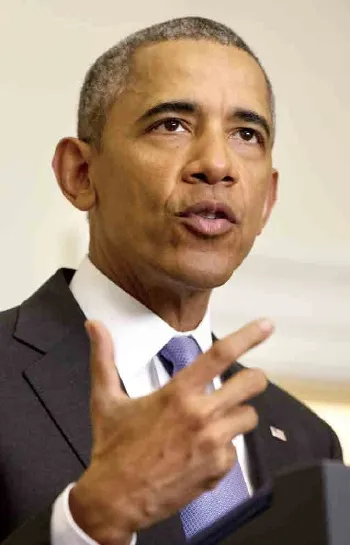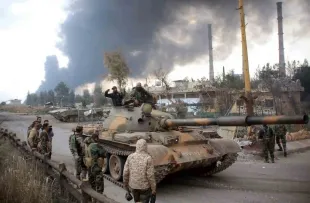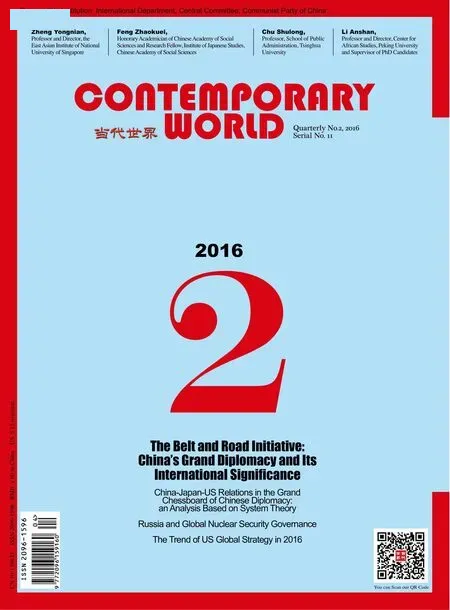The Trend of US Global Strategy in 2016
2016-11-23CHUSHULonG
CHU SHULonG
Professor, School of Public Administration,Tsinghua University
The Trend of US Global Strategy in 2016
CHU SHULonG
Professor, School of Public Administration,Tsinghua University

American President Obama delivered a speech at the White House, Washington, on January 17, 2016, remarking the allround implementation of the agreement on Iran nuclear issue marks a victory of the US foreign diplomacy.
2016 is the last year of the Obama Administration and there has been for long a saying both within the US and without it that the final year of a Presidency is a difficult year to do anything for the President, who is even taken for a “lame duck”. The saying, right for domestic politics in the US, does not match the fact for US diplomacy. As the US Constitution and political system give the main domestic power to the Capitol,in election year, both the Republicans and Democrats intensify their struggle to win the elections and, especially, when the party in opposition controls one or both chambers of the Congress, it will never render the White House any opportunity to make political gains. Thus the President faces piling difficulties in internal affairs. However, in foreign affairs, the President can still have things done. As power of diplomacy is mainly given to the President by the US constitution and political system,the President has a freer hand from the Capitol. Furthermore in election year, the more difficulties the President encounters in domestic politics, the more he will work on foreign policy so as to leave behind him more political results and diplomatic legacy. Therefore, most of the US presidents become “diplomatin-chief” during the final year of their rule, that is, to focus the energy of trier presidency on foreign affairs.
THE CoRE oF US GLoBAL STRATEGY REMAIns To MAInTAIn US “LEADERsHIP”
When coming to power in 2009, Obama impressed the US and the rest of the world as a “moderate” leader, different from his predecessor George W. Bush. Not being a conservative, he had stood against the Iraq War and for cooperation with allies and all countries of the world. To change the negative US image from the Iraq War among US allies and the rest of the world, the Obama Administration in its first year came up with“smiling diplomacy” and “listening diplomacy”, the President himself, the Vice President and the Secretary of State raveled up and down the globe, displaying “modesty”, “low profile” and“moderation” and accomplishing the mission of changing the national image.
However, there has been little change in substance of the US foreign policy. In fact, only a year after being “modest” and“moderate”, the Obama Administration immediately turned tooffensive in foreign policy. First of all,it put forward a new strategy of “pivot to Asia” and “re-balancing”, provoked the issue of the South China Sea at the ASEAN Regional Forum in Hanoi in summer that year, and later began to push for the Trans-Pacific Partnership(TPP) to write economic and trade“rules” for the Asia-Pacific in the 21st century. In the Middle East, the US supported and intervened in the “Arab spring”, the so-called “Democratic Revolutions” in the Middle East and North Africa, leading to increased turbulence and war havoc in the region that last to this day. In Europe, Obama visited East Europe, moving the NATO and its military deployment towards East Europe and border areas of Russia. Later,the US intervened and supported“democratic revolution” in Ukraine,checking Russia and putting it under sanctions.
Practice of the past seven years and more attests to the fact that Obama,though in image, rhetoric and appearance is not an extreme, willful US leader, is not fundamentally different from any other US presidents in understanding and implementing US foreign strategy on substantial issues,all of whom take the US for the “leader of the world”, all up to maintaining the US “leadership”, “preeminence” or“hegemony” and all up to taking “balancing”, “limiting” and “precautious”policy against non-Western countries like China and Russia and up to taking “containment” and hostile policy against the DPRK, Libya, Syria and Iran. In the final year of his rule, it is impossible for Obama to change the core content and objectives of US global strategy in any way, which he can only strengthen.
In EURoPE, THE US WILL conTInUE To kEEP RUssIA DoWn
There are two basic points in postwar US Europe strategy, to control Europe and to keep the Soviet Union/Russia down. The international financial crisis has devastated Europe, its interest and role in the international affairs being noticeably weakened and its contradictions, differences, divergence and resistance against the US global strategy being on the way down. There are no noticeable challenges towards US security to control Europe through the NATO. The focus of US Europe strategy is on checking Russia.
The source of the hardline Russia strategy of the US-led West is their long fixed cognition of Russia, namely that based on its history, culture and tradition, it is difficult for the country to become a true liberal democracy under the rule of law, that by tradition,Russian foreign policy is expansionary so much so that in the long term Russia will remain a threat and adversary to the US-led West, and that the US-led West should avail themselves of all opportunities and possibilities to weaken Russia so that it cannot stage a comeback and again pose a real challenge to the US-led West.
Therefore, since the disintegration of the Soviet Union and the end of the Cold Was in 1991, the Russia strategy of the US-led West has remained unchanged, that is to make full use of the strategic opportunity of the disintegration of the Soviet Union and the collapse of socialist countries in East Europe, to expand the EU and the NATO to the maximum, to absorb Eastern European countries into the Western camp to the maximum and to isolate Russia and to depress its strategic space to the maximum. This helps explain why the US-led West should have made such great reaction over the return of Crimea to Russia and the Eastern Ukrainian Crisis and why they should have been so stern with Russia.
As such, one can conclude that as long as the negotiations between Ukraine, Russia, France and Germany cannot product satisfactory results for the US-led West and cannot guarantee that Russia will no longer attempt to change the post-Cold War political and security boundary of Europe, the sanctions and hostility to Russia by the US-led West will continue and so also will the eastward expansion of the EU and NATO. Russia's sphere of influence, position, role and influencein Europe will continue to be limited and weakened by the US-led West. The long-term goal of the US global strategy is to make Russia a regional power with some influence in Central Asia and the Far East and not any longer a global power or European power. Such is the long-term strategy that every US president including Obama will keep implementing.

The Syrian foreign ministry released a statement on February 23, 2016, which declared that the Syrian government accepted the agreement between the US and Russia on ending hostilities among conflicting parties in Syria. The picture features a scene taken on February 21, 2016, near Aleppo that the Syrian government forces patrol the regained thermal power plant.
In THE AsIA-PAcIFIc, THE FocUs oF US sTRATEGY Is To consTRAIn, “BALAncE” AnD cHEck CHInA BY MAkInG UsE oF THE IssUEs oF EAsT CHInA SEA, SoUTH CHInA SEA AnD TAIWAn AnD WITH THE HELP oF THE TPP
As China continues to enhance its comprehensive national strength in economic, military and science and technology areas, the strategic awareness of the US in anxiety, vigilance,on guard against and checking China is on the increase. From this, one can conclude that either in the final year of the Obama Administration or under a new President, the US “rebalancing strategy” in Asia against and constraining China tends to intensify.
There will be both continuity and “innovation” on US measures to carry out the “rebalancing strategy”. Continuity as in the US continuing to strengthen its military deployment in the West Pacific, making use of the issues of the East China Sea and the South China Sea to check and “balance” China and to maintain its alliance system and regional order in Asia. The extreme reaction of the US on the South China Sea is mainly because China's actions there pose a threat and challengein the future to its freedom of military navigation in the South China Sea and the West Pacific at large and its seeking of hegemony in the Asian-Pacific region, and the US cannot tolerate such actions or any actions that threaten and challenge its world leadership position and role. It can be foreseen that the Obama Administration and a new US Administration in the future will go on sendingwarships and warplanes to conduct “freedom of navigation” patrols around Chinese islands and rocks in the South China Sea, threatening China's sovereignty and security and causing local tension and antagonism in China-US relations.
Over the past seven years, the situation of the Taiwan issue has been relatively stable, thanks mainly to the peaceful development of the crossstrait relations. In the future, as the Democratic Progressive Party returns to power in May 2016 and for the first time in history controls both the executive and legislative branches of government, the words and deeds for Taiwan independence will for sure return to Taiwan politics. It will be a test to the US: whether to continue with the attitude of the Bush Administration not to support and even to“oppose”Taiwan independence or to make use of the new situation to overtly or covertly use Taiwan independence forces to “balance” mainland China. Should the Obama Administration or a future US administration make the wrong remarks or moves on the Taiwan issue, it would necessarily lead to new tension and antagonism in China-US relations.
In the coming year, the Obama Administration will continue to push for the Trans-Pacific Partnership Agreement (TPP) in order to regain US leading power and position in the economic field in the Asia-Pacific and to “balance” the rise of China and its effects in the economic field. In 2016,the Obama Administration will try to secure congressional approval of the agreement, there being certain uncertainty in the election year. Many Democratic congressmen, congresswomen and senators and presidential candi-dates are long standing opponents to free trade whereas on the contrary, the Republican congressmen, congresswomen and senators and presidential candidates are by tradition free traders. In the election year, where they are heading is a matter of uncertainty.
During the Obama Presidency, a policy of no contact has been in place for the DPRK. In recent years, the Obama diplomacy has been quite fruitful,reaching a nuclear agreement with Iran and improving relations with Cuba by a large margin, restoration of diplomatic tie included. Furthermore,Obama plans to make a historic visit to Cuba in the coming year, opening a new epoch of US-Cuba relations and writing an extraordinary page in the US diplomatic history. However, in regard to the DPRK, since the DPRK has kept conducting nuclear tests, it is impossible for the US to have the intent to improve relations with the country. But rather, the US will surely to increase sanctions on the DPRK and take more radical, high pressure military actions. At present, it is pushing for the deployment of Terminal High Altitude Area Defense (THAAD)anti-missile system in the ROK. In the coming couple of years, the situation of the Korean Peninsula is full of dangers. It can be foreseen that should the DPRK take any offensive military actions against the ROK, the US and the ROK would conduct severe military attacks on the DPRK, and the situation of the Korean Peninsula would become very serious indeed, putting China's national security to severe test.
In THE MIDDLE EAsT,THE US Is AT THE HoRn oF DILEMMA BETWEEn THE oLD AnD nEW sTRATEGIEs,DIFFIcULT To MAkE A DEcIsIVE MoVE
Since the outset of the 21st century,the US has vigorously pushed for“democratic revolutions” in the Middle East, launching the Iraq War and removing the Saddam regime by the force of arms, participating in the NATO bombardment of Libya and overthrowing the Gaddafi regime,supporting the “Arab spring” in Egypt and other countries in the Middle East and North Africa, and supporting Syrian oppositions and urging Bashir Al-Assad to step down.
The strategic moves of the US have caused more war havoc, millions of people being displaced and millions of refugees rushing into Europe. The order of nation-states in the Middle East is broken. An extremist terrorist organization the Islam State has risen in the vacuum, cause serious devastation to peace and stability in the Middle East and the world at large.
Under these circumstances, the US so far has not admitted its responsibilities and failure. However, it cannot avoid criticisms from the whole world including its European allies. Within the US, there is rethinking and reflections, in face of which readjustment is still limited and less than clear cut. No longer does the US strongly call for the downfall of Bashir Al-Assad but it still refuses to cooperate with the Bashir regime in cracking down on the Islam State. To newly emerged contest among major regional countries like Turkey, Saudi Arabia and Iran, the US has adopted a detached attitude of not being involved and not taking positions.
It is not difficult to see that the US remains rethinking and readjusting its Middle East policy, but overall it is hesitant to take a decisive move, being ambiguous and vague in direction. The Middle East is one of the regions causing most headaches for the US. The US can neither get away from it nor control the development of situation there. Such is what faces Obama in his last year in office and a new US president to succeed him. The US has kept putting in a lot of military, political and diplomatic resources in the Middle East with very limited effects,and even with effects running contrary to its policy objectives and aspirations.
THE PosT-OBAMA TREnD oF US GLoBAL PoLIcY
In sum, there has been continuity in the US global strategy in the past seventy years since the end of the World War II as between Democrat and Republican administrations there are few differences on maintaining the US leadership, preeminence and hegemonic position. Differences lie in tactical matters such as concrete ways,methods, means and priorities of doing things in implementing the strategy due to varying personal experience,knowledge and characters of different leaders.
Among the politicians of both Democratic and Republican Parties, there are quite a few of people who entertain more negative understanding and feelings for non-Western major countries like China and Russia and the third world countries than Obama with a more willful character. At present,among the presidential candidates of both parties such as Hilary Clinton on the Democrat side and Trump on the Republican side, such tendency is on display. However, the practice of US diplomacy and that of international affairs over the years attest to the fact that the world is no long a place for the US to seek hegemony at will and the US cannot do what it pleases in international affairs.
It can be predicted that if a willful-Democrat or Republican candidate is elected US president, in his or her first year of office as a learning and transitional period, the US global strategy will be more different in form than the first year of Obama presidency. The US is no longer in crisis. Rather,its economic situation is the best of developed countries and many Americans consider it as the best of all major economies. The international image of the US is no longer negative as related to George W.'s Iraq War. The US has regained reliance and support of allies,old and new. In the Middle East, the US intervention is likely to be more forceful. A new president may be more willful to countries like Russia and China. For a period of time, the contradictions and antagonism between the US and the third world countries like China and Russia may tend to intensify.
杂志排行
Contemporary World的其它文章
- NIcos AnAsTAsIADEs
- Spring Trains
- Shift in Global Climate Governance and China's Contributions
- China-Africa Relations Raised to a New High
- Development Trend of“16+1 Cooperation”after the Suzhou Summit: A Response from Central andEastern European Think Tanks
- Comprehensively Upgraded China-EU Relations Takes Early Shape
